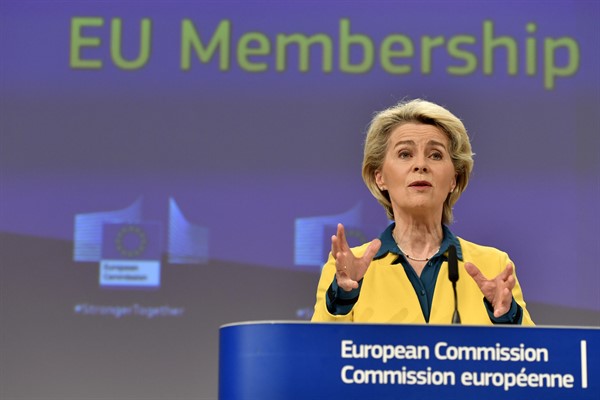In the days before Ukraine’s European Union candidate status was confirmed on June 23, a satirical clip from Ukrainian President Volodymyr Zelenskyy’s previous career as a comic actor began to circulate on social media. In a scene from the television series “Servant of the People”—in which Zelenskyy played a schoolteacher who accidentally becomes Ukrainian president, not long before Zelenskyy himself became president in real life—he takes a call from then-German Chancellor Angela Merkel. After initially congratulating Zelenskyy’s character for Ukraine’s accession to the EU, Merkel—who remains an off-screen voice heard only through the phone—suddenly apologizes, realizing she’s made an error: She had actually meant to call the president of Montenegro instead.
Zelenskyy’s portrayal of surprise, joy, shock and disappointment in the 20 seconds the call lasts is a masterpiece of comic timing. But it also encapsulates how frustrating accession is for states struggling to become members of the EU. The achingly slow process begins with a succession of steps those states must take to harmonize their regulatory codes with the EU’s before being declared an official candidate for membership. For societies still struggling with legacies of dictatorship and civil conflict, implementing the reforms necessary to meet the requirements of the EU’s Copenhagen criteria, such as the capacity to implement European law, a stable market economy and a democratic political system, amounts to a complex struggle.
In addition, the extent to which even the smallest member state can influence EU decision-making means that the accession process is fraught with uncertainty. That the EU as an entity is itself becoming more state-like generates a growing number of challenges for states seeking accession, too. Candidate states now need to integrate into a collective border system, currency and environmental policy, as well as into the EU’s increased harmonization in core aspects of governance, such as taxation and defense. All of this blends their national sovereignty with the EU’s supranational sovereignty to a much greater extent than their predecessors faced before the Maastricht Treaty ushered in the EU in its current form in 1992.

